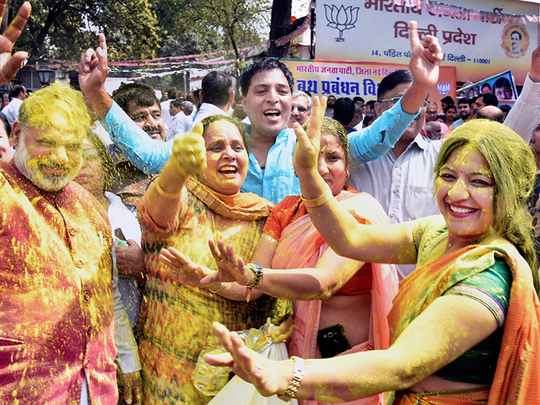
Dubai: Four years after Prime Minister Narendra Modi stormed to power in June 2014, his Bharatiya Janata Party’s victory march continues, capturing vast swathes of political landscape, a remarkable performance that is not seen in a quarter of a century.
Saturday’s results for elections held in Tripura, Nagaland and Meghalaya — states located in the north-eastern tip of India — show that the BJP is unstoppable and invincible.
The numbers thrown by these results speak volumes about the BJP’s capability in decimating the opposition in their own backyard.
Before dissecting the electoral statistics, let’s go back to months leading to the 2014 general elections when Modi was criss-crossing the nation, almost in a frenzied manner, mobilising public support for himself and his right-wing party.
His mega rallies, covered live on TV, was attended by tens of thousands of people who were hypnotised by his aggressive and ruthless attacks on Congress leaders who were in power.
Saffron surge in India
Tripura was one state where people showed little interest in Modi and his rallies drew a small crowd.
Moreover, an year earlier, the BJP had polled just 1.5 per cent votes and almost all its candidates lost their security deposits.
In a remarkable change of fortunes on Saturday, the BJP got a massive 43 per cent vote share, winning 35 of 59 seats in the state legislature.
of the 1.25 billion Indians now live in BJP-ruled states
The party handed a humiliating defeat to Manik Sarkar, a Communist politician who ruled the state for 20 years. Sarkar’s image of an honest leader who led a modest life did not work this time. In the neighbouring states of Meghalaya and Nagaland too, the BJP and its allies delivered a modest performance.
states in India are now ruled by the BJP
Today, the BJP rules 21 states against the seven it held when Modi became the prime minister.
In other words, over 840 million or over 70 per cent of 1.25 billion Indians now live in BJP-ruled states.
BJP’s vote share in the just concluded Tripura election
Buried deep in the electoral statistics, however, is a fascinating success story, a story of acceptability in a nation so diverse — geographic, ethnic and linguistic — that sometimes it is hard to imagine India as one country.
The BJP had a humble beginning with just two elected MPs in 1984 and remained a party of Baniyas, the trading community which formed its core support group attracted by its aggressive nationalist, pro-Hindutva pitch.
Modi’s emergence on the national scene changed the party’s acceptability and composition dramatically.
He invented a unique political pitch, mixing development and governance with aggressive nationalism, a potent combination that attracted people from various socioeconomic groups — from poor farmers and the middle-class to the top industrialists. Also, Modi’s promise of governance — development for all and appeasement for none — struck a chord, effectively cornering the Congress, a party with a socialist tilt and which followed the Nehruvian vision of protecting India’s minorities.
Saturday’s results show that the acceptability of the right-wing party is growing even in regions that bucked national trends. Nagaland, one of three Christian dominated states is a good example. Here, the BJP won 12 and its ally bagged 27 seats. In the neighbouring Meghalaya, where 75 per cent of population is Christian, including Baptists and Catholics, the BJP got a modest 9.6 per cent votes. The party’s expansion in remote corners of India, however, has come at a cost.
It was forced to dilute its ideology of Hindutva and speak in a political language that was acceptable to people. For example in Meghalaya, the BJP announced that it has no problem with slaughter of cow and consumption of beef. In other parts of India — Haryana and Uttar Pradesh in north, Maharashtra in west and Madhya Pradesh in central — the BJP governments have introduced tough laws, making slaughter of cows and possession of its meat a criminal offence.
Since 2014, scores of Muslims have been murdered by right-wing mobs for possessing cow meat and live animals. In Nagaland, weeks after ending a federal subsidy given to Muslims for Haj, the BJP offered to send Christians to Jerusalem at state expense. The most shocking was Tripura, where the dominant Bengali-speaking voters have always voted for Communists. Modi has also indicated that he is willing to reach out to Muslims, a community that has so far stayed away from the BJP. On Saturday, while addressing the BJP workers, he paused for a few minutes as Muslim calls of prayer played from nearby mosques in New Delhi.
The BJP’s growing acceptability is clearly bad news for the Congress, a party once known as India’s ‘natural party of governance’ and the only party to have a matching record when it ruled 15 states in 1993.
Today, it appears Modi is set to deliver on his promise of delivering a ‘Congress Mukt Bharat’ or an India without Congress. The only way the Congress can avoid total decimation is by learning to exploit the BJP’s weaknesses — its inability to counter the opposition when it is defending a state and fighting anti-incumbency. Three big BJP-ruled states, Rajasthan, Madhya Pradesh and Chattisgarh, will go to polls later this year and the poll outcome will set the ball rolling for general elections in March 2019.












